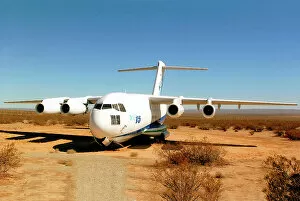Yc 15 Collection
The McDonnell Douglas YC-15, with its serial numbers 72-1876 and 72-1875, was a groundbreaking aircraft that revolutionized military transport capabilities
For sale as Licensed Images
Choose your image, Select your licence and Download the media
The McDonnell Douglas YC-15, with its serial numbers 72-1876 and 72-1875, was a groundbreaking aircraft that revolutionized military transport capabilities. Designed as a prototype for the United States Air Force's Advanced Medium STOL Transport (AMST) program in the early 1970s, this impressive machine showcased exceptional performance and versatility. With its distinctive twin-engine configuration and high-mounted wings, the YC-15 boasted remarkable short takeoff and landing capabilities. Its advanced design allowed it to operate from unprepared runways, making it an invaluable asset in remote or austere environments. This feature alone set it apart from traditional transport aircraft of its time. Equipped with powerful engines and an efficient cargo hold, the YC-15 could carry substantial loads over long distances without compromising speed or maneuverability. Its spacious interior accommodated troops, vehicles, or bulky equipment effortlessly - truly a workhorse of the skies. During testing phases, these two specific models proved their mettle by successfully completing numerous flight trials under various conditions. Their reliability and adaptability impressed both pilots and engineers alike. Although ultimately losing out to its competitor in the AMST program (which led to the development of what is now known as C-17 Globemaster III), the YC-15 left an indelible mark on aviation history. It paved the way for future advancements in military transport technology while serving as a testament to McDonnell Douglas' engineering prowess. Today, remnants of this pioneering aircraft can be found in museums around the world - silent reminders of how innovation continues to shape our skies. The legacy of the McDonnell Douglas YC-15 lives on through subsequent generations of military transports that owe their existence to this trailblazing prototype.



